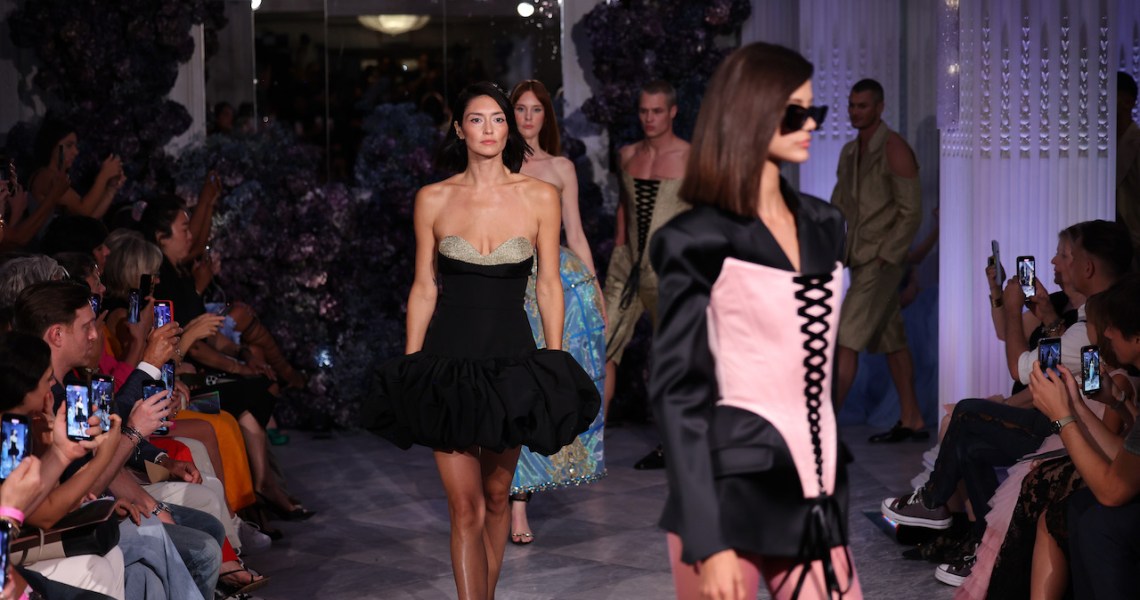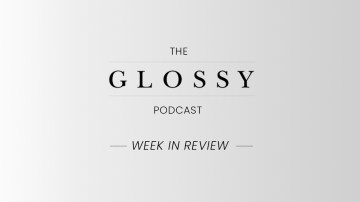This week, a close look at luxury brands’ shared aim of carving out a distinct, accessible lifestyle. Scroll down to use Glossy+ Comments, giving the Glossy+ community the opportunity to join discussions around industry topics.
Fashion week, as it stands for brands, is an important branding moment among an increasing number of important branding moments.
The strength of consumer curiosity based solely on a brand’s name and story was proven by the TikTok-fueled acceleration of fragrance sales at the height of the pandemic, said Jean Madar, CEO and chairman of Interparfums. Now, to a heightened extent and with a new focus on accessibility, luxury brands are building out the story they’re telling, leveraging channels from Spotify to stores to fashion week runways.
Of course, there’s a fine line between brands that are aspirational and those that are out of reach. To fall on the former side of the spectrum and reach more consumers, luxury brands are upping their focus on facilitating connectivity at the moment curiosity strikes. A large part of that is presenting product options that are affordable or even free.
“Don’t underestimate brick-and-mortar; brick-and-mortar is part of the [brand] experience,” said Madar, adding that stores account for 75-80% of Interparfums’ U.S. distribution. Interparfums owns the fragrance licenses of luxury fashion brands including Ferragamo, Oscar de la Renta and, as of its July acquisition from Coty, Roberto Cavalli. Madar noted that taking full advantage of physical retail requires first “selling” store associates on the brand and its story. As such, Interparfums has two U.S. training teams, each focused on educating these brand ambassadors.
Also important is providing in-store customers with an “attractive offer,” like a gift with purchase, so they have “no excuse not to buy,” Madar said.
On the fragrance front, more luxury brands are going there for the first time. Over the last two weeks, Gabriela Hearst announced it will debut two fragrances this month, and Ann Demeulemeester came out with its take, dubbed “A,” on Thursday. Dior, meanwhile, has been building on its successful fragrance portfolio, celebrating the September launch of its new L’Or de J’adore with a star-studded fete this week.
Madar said Roberto Cavalli has yet to tap into its full fragrance potential, which he owed to the size and demands of its former owner; unlike Interparfums, Coty has a diverse product focus inclusive of skin care and makeup, he pointed out. Meanwhile, Cavalli has a “huge heritage” while at the same time being culturally relevant — both Taylor Swift and Beyoncé have worn the brand on stage during their current tours. With Coty, Roberto Cavalli fragrances did $40 million in annual sales.
Capturing the brand’s signature bold, sexy lifestyle in a bottle is Interparfums’ task at hand. Madar said warm, gourmand and voluptuous fragrance notes will be a fit. The company plans to release two Cavalli scents in 2024.
“I strongly believe a brand should be associated with a scent,” he said, calling Abercrombie & Fitch an innovator for making its scent a signature 25 years ago via its potent stores.
“With [an investment of] $50 or $100, a [consumer] can enter the world of a designer they can’t otherwise afford,” Madar said. “They paid their fee, and they’re entered into a family; they feel like they’re among a lucky few.” Roberto Cavalli dresses are often upward of $2,000.
Madar said that, unlike many luxury brands, Interparfums has not recently raised its prices. In fact, to up the value of the fragrance opportunity, as well as the fragrance quality, the company has focused on increasing the concentration of its formulas, which extends the lasting power of their scents.
Based on overall inbound interest, Madar confirmed that an increasing number of fashion brands, including jewelry and accessories companies, are aiming to build out a lifestyle by expanding their product focus. And they’re looking to fragrance amid the category’s accelerated growth.
Brands are no doubt taking cues from OG fashion-lifestyle brand Ralph Lauren, which presented its first New York Fashion Week show after four years on Friday. Entry points for young or lower-income consumers range from cups of Ralph’s coffee to Polo Ralph Lauren shirts. And each reflects the brand’s signature quality and all-American prep.
But the first step to selling a lifestyle is defining it.
For his part, Jackson Wiederhoeft plans to drive home his 4-year-old brand’s lifestyle through its runway show, set for Tuesday.
“How people experience the collection feeds into the whole [brand] narrative,” he said. “[A fashion show] is definitely a big investment .. but drama is so essential to the brand. And the clothes come to life in a whole new way on the runway.”
Along with clothes walking a catwalk, the Wiederhoeft show will reinstate the brand’s signature drama through “the performance, the scenery, the choreography, the music and the ‘lights, camera, action,’” he said. The show will be streamed across the brand’s social channels.
Another strong example of a brand lifestyle clearly communicated on the runway this week was Christian Siriano’s show on Friday. Siriano’s signature glam style was represented in grand floral arrangements, metallic and sparkly dresses, and a live soundtrack — courtesy of Sia — with lines like, “Shine bright like a diamond.”
It’s worth noting that Siriano is among the designers offering public access to their shows this season by way of sold tickets. Meanwhile, before the start of the Tibi show on Saturday, the brand’s designer, Amy Smiolvic, told Glossy that half of the invited guests were “favorite” customers, rather than influencers or press.
All in all, providing access to brand fans is trending.
On September 7, Spotify launched an in-app destination featuring playlists by fashion designers and the “New York Fashion Week Official Playlist” — the latter via a partnership with the CFDA. The Official Playlist includes songs compiled by brands including Khaite and Caroline Herrera.
On the same note, brands including The Row and Aimé Leon Dore have made a habit of dropping monthly playlists on their marketing channels. In sharp contrast to their wearable designs, their downloadable song lists are free.
Want to discuss this with our editors and members? Join here, or log in here if you're already a member.




